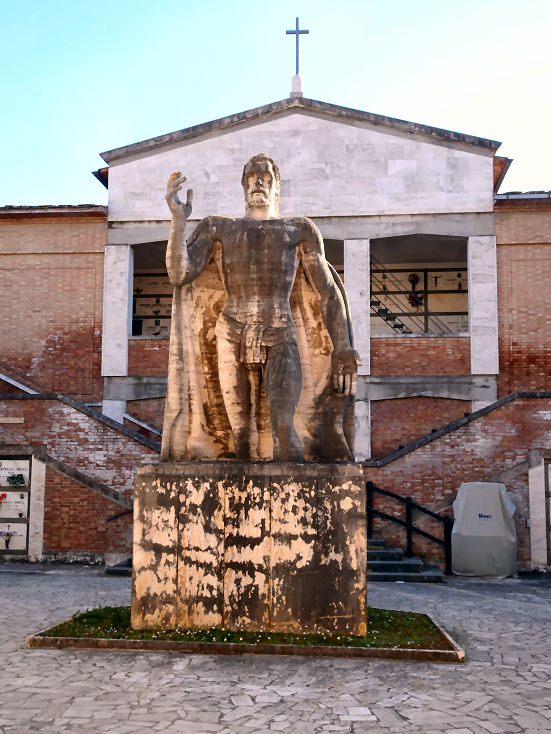 |
|
|

|
Monumental Cemetery of
the Misericordia |
||
|
History The Camposanto della Misericordia is run by the archconfraternity of the Misericordia, based in The Misericordia oratory building in Siena It is something of a showplace of 19th century Sienese sculpture and art. The cemetery was built between 1835 and 1843 based on designs by the architect Lorenzo Doveri on the site of a demolished Olivetan convent just outside the city walls, beyond the Porta Tufi. Doveri died in 1866 and responsibility passed to his pupil, and Siena's foremost Purist architect, Giuseppe Partini to undertake expansion. This work was largely completed by 1875. More modern additions do not blend well with these 19th century structures. The original core of the cemetery consists of two large fields on different levels and linked by steps (see right). Here you'll find much fine work by the leading local sculptor Tito Sarrocchi, who had studied in Florence under Bartolini and his fellow Sienese master Giovanni Duprè, and who was responsible for the copy of the Fonte Gaia by Jacopo della Quercia, now in the plaster cast gallery of the Santa Maria della Scala Complex. The Deposition by Duprè, now in the Bichi Ruspoli Chapel here, won him an honorary gold medal at the Paris Exhibition of 1867, and the praise of poet Aleardo Aleardi who said he was an 'ideal artist: ancient form and modern feeling, a Christian soul with a Greek chisel'. Under the arcades are large vaulted underground galleries, accessed by spiral staircases and larger flights. Down here is also the Voltoni. Held up by large clay pillars, it is thought to have been the crypt of the demolished Olivetan convent (see photos at the bottom of this page). The large statue of The Risen Christ in the  courtyard of the main entrance
(see right)
is by the Sienese sculptor Vico Consorti and was made for the renovated
crypt of San Domenico,
where in November 1938 the remains of ten local 'fascist martyrs' were
ceremoniously placed in a specially designed sacrario. No trace of
this sacrario remains, but the Risen Christ was brought here. No
label is attached to even hint at its history courtyard of the main entrance
(see right)
is by the Sienese sculptor Vico Consorti and was made for the renovated
crypt of San Domenico,
where in November 1938 the remains of ten local 'fascist martyrs' were
ceremoniously placed in a specially designed sacrario. No trace of
this sacrario remains, but the Risen Christ was brought here. No
label is attached to even hint at its history The Purists The architect Giuseppe Partini and sculptor Giovanni Duprè, mentioned above, were part of a movement called the Purists who, like the Pre-Raphaelites and and Nazarenes rejected neoclassicism and took their inspiration from the early Renaissance. Partini it was who removed the baroque accretions from San Francesco and reworked the façades of three palazzi in Piazza Salimbeni. He often worked with the sculptor Tito Sarrocchi, a pupil of Duprè, who was also responsible for many sculptures in the cemetery. Opening times Winter 8:30 to 12.00/14:00 to 17.00 Summer 8.30- 12.30/15.30-19.00
Opening limited to the morning on 1st and 6th January, the Sunday of
Easter, April 25th, May 1st, July 2nd, August 15th and 16th, December 25th
and 31st.
|
|
|
